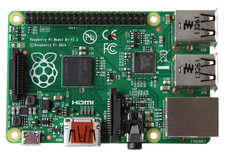Exploring the new Rasp Pi Model B+
Pi Plus

© Lead Image © Raspberry Pi Foundation
The brand new Raspberry Pi Model B+ is solid and tidy, with many clever improvements in detail that make this the best version so far. The desired improvement in performance will have to wait for now.
More than three million Raspberry Pi computers have already been sold. Originally designed to introduce school children to computers, the tiny device has been used as a small server, a media center, an embedded PC in industrial products, and more. The queen of England even honored the project with a visit, and she was amused.
In July, a refurbished Rasp Pi appeared in the form of the Raspberry Pi Model B+. Although the board for this model is still based on the Broadcom-SoC-BCM2835 with 512MB of main memory, the Raspberry Pi Foundation implemented many improvements in its details (see "Why No Improved Performance?"). Users who need more RAM or gigabit Ethernet will have to wait for another model: According to the Foundation, the next Rasp Pi will appear at the end of 2016 at the earliest.
First Impression
A quick look at the circuit board of the Raspberry Pi Model B+ reveals a spiffed up layout. Although the B+ is the same size as the old Model B, it is easier to grab thanks to its rounded edges. Moreover, four holes make it possible to fasten the housing and other accessories more securely. The large capacitor that stuck out so prominently on the Model B and was easy to break off is gone, thanks to the cleaned up power circuitry, and the USB and Ethernet ports now connect flush with the circuit board. The audio out jack moved to the opposite side of the board behind the Ethernet port, but the connectors for camera and GPIO generally remain in the same places.
[...]
Buy this article as PDF
(incl. VAT)
Buy Linux Magazine
Subscribe to our Linux Newsletters
Find Linux and Open Source Jobs
Subscribe to our ADMIN Newsletters
Support Our Work
Linux Magazine content is made possible with support from readers like you. Please consider contributing when you’ve found an article to be beneficial.

News
-
Two New Distros Adopt Enlightenment
MX Moksha and AV Linux 25 join ranks with Bodhi Linux and embrace the Enlightenment desktop.
-
Solus Linux 4.8 Removes Python 2
Solus Linux 4.8 has been released with the latest Linux kernel, updated desktops, and a key removal.
-
Zorin OS 18 Hits over a Million Downloads
If you doubt Linux isn't gaining popularity, you only have to look at Zorin OS's download numbers.
-
TUXEDO Computers Scraps Snapdragon X1E-Based Laptop
Due to issues with a Snapdragon CPU, TUXEDO Computers has cancelled its plans to release a laptop based on this elite hardware.
-
Debian Unleashes Debian Libre Live
Debian Libre Live keeps your machine free of proprietary software.
-
Valve Announces Pending Release of Steam Machine
Shout it to the heavens: Steam Machine, powered by Linux, is set to arrive in 2026.
-
Happy Birthday, ADMIN Magazine!
ADMIN is celebrating its 15th anniversary with issue #90.
-
Another Linux Malware Discovered
Russian hackers use Hyper-V to hide malware within Linux virtual machines.
-
TUXEDO Computers Announces a New InfinityBook
TUXEDO Computers is at it again with a new InfinityBook that will meet your professional and gaming needs.
-
SUSE Dives into the Agentic AI Pool
SUSE becomes the first open source company to adopt agentic AI with SUSE Enterprise Linux 16.

